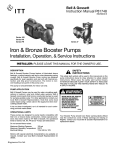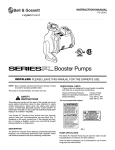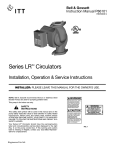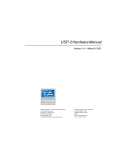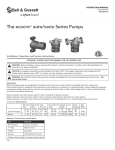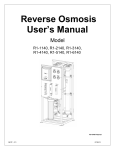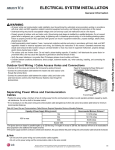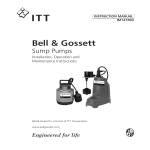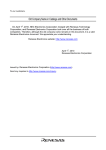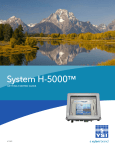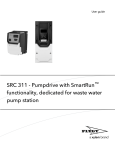Download Installation Instructions
Transcript
INSTRUCTION MANUAL P76966E Booster Pumps INSTRUCTIONS FOR THE FOLLOWING B&G PRODUCTS: 21/2", LD3, HD3, PD35, PD37, 1HP & 11/2HP INSTALLER: PLEASE LEAVE THIS MANUAL FOR THE OWNER’S USE. DESCRIPTION For applications requiring higher flow and head pressures, Bell & Gossett provides an entire range of booster pumps. The designs of these pumps are based on three-part configuration which offers complete field repairability and compact construction. All Bell & Gossett boosters are equipped with the incomparable B&G manufactured motor for quiet and efficient operation. SAFETY INSTRUCTIONS This safety alert symbol will be used in this manual and on the pump safety instructions decal to draw attention to safety related instructions. When used, the safety alert symbol means ATTENTION! BECOME ALERT! YOUR SAFETY IS INVOLVED! FAILURE TO FOLLOW THE INSTRUCTIONS MAY RESULT IN A SAFETY HAZARD. These pumps are for indoor use only. WARNING PUMP APPLICATION Bell & Gossett Booster Pumps may be used for hydronic heating and cooling systems, domestic water, industrial applications and general service operations. Bell & Gossett recommends that bronze constructed pumps be used for pumping potable water. OPERATIONAL LIMITS V56845 These pumps are designed to pump liquids compatible with their iron or bronze body construction. This pump line delivers maximum capacities from 100 GPM to 150 GPM. Unless special provisions have been made by ITT Bell & Gossett, the operational limits for Series 21/2", LD3, HD3, PD35, PD37, PD38 & PD40 Pumps are listed below. Max. Working Pressure: Max. Operating Temperature: Electrical Rating: (1/4 HP only) BEFORE INSTALLING, USING OR SERVICING THIS PRODUCT, READ THE WARNING NOTES AND INSTRUCTIONS IN INSTRUCTION MANUAL. FAILURE TO DO SO MAY RESULT IN SERIOUS INJURY OR PROPERTY DAMAGE 125 psi 225°F 115/230V, 60 Hz, 1PH 208-230/460V, 60 Hz, 3PH 115V or 230V, 60 Hz, 1PH Motors with special electrical characteristics are available on request. Contact your local Bell & Gossett Representative for details. Your Booster Pump should have this warning label affixed to the pump near the conduit box cover. If this warning is missing or illegible, contact your local Bell & Gossett Representative for a replacement. SAFETY REQUIREMENTS MECHANICAL SAFETY ELECTRICAL SAFETY WARNING: EXCESSIVE SYSTEM PRESSURE HAZARD The maximum working pressure of the pump is listed on the nameplate – DO NOT EXCEED THIS PRESSURE. Failure to follow these instructions could result in serious personal injury, death and/or property damage. WARNING: ELECTRICAL SHOCK HAZARD Electrical connections are to be made by a qualified electrician in accordance with all applicable codes, ordinances and good practices. Failure to follow these instructions could result in serious personal injury, death and/or property damage. WARNING: EXCESSIVE PRESSURE HAZARD – VOLUMETRIC EXPANSION The heating of water and other fluids causes volumetric expansion. The associated forces may cause failure of system components and the release of high temperature fluids. This can be prevented by installing properly sized and located compression tanks and pressure relief valves. Failure to follow these instructions could result in serious personal injury, death and/or property damage. WARNING: ELECTRICAL OVERLOAD HAZARD Three phase motors must have properly sized heaters to provide overload and under voltage protection. Single phase motors have built-in overload protectors. Failure to follow these instructions could result in serious personal injury, death and/or property damage. THERMAL SAFETY WARNING: EXTREME TEMPERATURE HAZARD If the pump, motor or piping are operating at extremely high or low temperature, guarding or insulation is required. Failure to follow these instructions could result in serious personal injury, death and/or property damage. WARNING: ELECTRICAL GROUNDING HAZARD Adequate electrical grounding is required for the safe operation of B&G Pumps. The use of grounded metal conduit assures this requirement. If the means of connection to the supply-connection box (wiring compartment) is other than grounded metal conduit, ground the pump back to the service by connecting a copper conductor at least the size of the circuit conductors supplying the pump to the green grounding screw provided within the wiring compartment. Failure to follow these instructions could result in serious personal injury, death and/or property damage. WARNING: HOT WATER HAZARD When disassembling a gasketed joint, always use a new gasket upon reassembly. NEVER REUSE OLD GASKETS. Failure to follow these instructions could result in serious personal injury, death and/or property damage. REMOVAL OF THE PUMP FROM EXISTING SYSTEM FOR REPLACEMENT WARNING: ELECTRICAL SHOCK HAZARD Disconnect and lockout the power before servicing. Failure to follow these instructions could result in serious personal injury or death. 1. Close the valves on the suction and discharge sides of the pump. If no valves have been installed, it may be necessary to drain the system. 2. Loosen the conduit box cover screw and remove the cover. WARNING: UNEXPECTED START-UP HAZARD Single phase motors are equipped with automatic reset overload protectors. The pump can restart without warning. Disconnect and lockout power before servicing. Failure to follow these instructions could result in serious personal injury, death and/or property damage. 3. Disconnect the electrical supply lines to the pump. WARNING: HOT WATER HAZARD Before draining the system, allow water to cool to 100°F max., open the drain valve (take precautions against water damage) and leave the drain valve open until servicing is complete. Failure to follow these instructions could result in serious personal injury, death and/or property damage. WARNING: ELECTRICAL SHOCK HAZARD Be certain the electrical power is not present at the motor leads before continuing. Failure to follow these instructions could result in serious personal injury or death. 2 WARNING: HIGH PRESSURE HAZARD Pressure may be present in the pump body. This pressure can be relieved by loosening the flange bolts and shifting the pump assembly slightly to allow the pressurized water to escape. Failure to follow these instructions could result in serious personal injury or death. 4. Remove the flange bolts and nuts and then remove the pump from the piping. PUMP INSTALLATION PUMP LOCATION Bell & Gossett booster pumps should be installed where there will be sufficient room for future inspection, maintenance and service. It is highly recommended that service valves (shut-off) also be installed on each side of circulator pumps to facilitate servicing or replacing the pump without draining the system. If it is required to lift the entire pump, do so with slings placed around the pump assembly as shown below. IMPORTANT: In closed systems, do not install and operate Bell & Gossett pumps, 3D valves, suction diffusers, etc., without properly sized safety and control devices. Such devices include the properly sized and located pressure relief valves, compression tanks and pressure, temperature, and flow controls. If the system is not equipped with these devices, consult the responsible engineer or architect before operating. TION. THIS MAY RESULT IN UNWANTED STRESS IN THE PUMP BODY, FLANGE CONNECTIONS AND/OR PIPING. The code for pressure piping, ANSI B31.1, lists types of supports for various applications. Ordinary wire or band hangers are not adequate to maintain alignment. It is very important to provide strong, rigid support for the suction and discharge lines. IMPORTANT: Do not support the pump by its power pack. To function properly, the power pack must not be restrained. PUMP FLANGES New Bell & Gossett flange gaskets must be installed between the flanges of the pump body and suction and discharge pipes. The gaskets should be clean and grease-free; old gaskets should never be reused. WARNING: HOT WATER HAZARD When disassembling a gasketed joint, always use a new gasket upon reassembly. NEVER RE-USE OLD GASKETS. Failure to follow these instructions could result in serious personal injury, death and/or property damage. WARNING: HOT WATER HAZARD Make sure that each flange gasket remains seated in the flange groove during and after installation. Failure to follow these instructions could result in serious personal injury, death and/or property damage. Apply torque in even increments to all (4) flange bolts using a diagonal tightening pattern to a value of 96-132 in-lbs. (8-11 ft. lbs.). Both the suction and discharge flanges must be torqued in this manner. PUMP SUPPORT AND PIPING Install the suction and discharge flanges on the pipe ends using Teflon ® * tape sealer or high quality thread sealant. Minimize strain on the pump by supporting the suction and discharge piping with pipe hangers near the pump. Line up the vertical and horizontal pipings so that the bolt-holes in both the pump and pipe flanges are aligned. DO NOT ATTEMPT TO SPRING THE SUCTION OR DISCHARGE LINES INTO POSI- MODE OF DISCHARGE Bell & Gossett Pumps can be installed to discharge up, down, left or right. The oiling ports must always be in the twelve o’clock position (on top) as shown below with the motor and bearing assembly always in a horizontal position as shown to the right. THE ARROW ON THE PUMP BODY MUST POINT IN THE DIRECTION OF THE FLOW. If it becomes necessary to change the mode of discharge, refer to B&G Instruction Manual HS-105-SM for specific instructions in removing the motor and bearing assembly from the pump body. WARNING: WATER LEAKAGE HAZARD To prevent leakage, make certain that the flange bolts have been adequately torqued. Failure to follow these instructions could result in serious personal injury and/or property damage. *Teflon® is a registered trademark of E.I. DuPont de Nemours and Company. NOTE: The position of the conduit box is determined by the model of the motor used and must be positioned on the bottom or the side of the motor housing. As shown to the left. 3 WIRING INSTRUCTIONS WARNING: ELECTRICAL SHOCK HAZARD Disconnect and lockout the power before making electrical connections. Failure to follow these instructions could result in serious personal injury or death. Remove the screws securing the conduit box cover (wiring compartment) and lift off the cover. Attach the appropriate size connector to the hole in the side of the conduit box. II. THREE PHASE MOTORS Three phase motors can operate at either low voltage (208230V) or at high voltage (460V). Determine the voltage you choose to operate your B&G pump. Wiring instructions for each option are listed below and are also found in the conduit box cover or on the motor nameplate. HIGH VOLTAGE L1 L2 L3 T1 T2 T3 T4 T7 T5 T8 T6 T9 I. SINGLE PHASE MOTORS Single phase dual voltage motors can operate at low voltage (115V) or high voltage (230V). Determine the voltage at which you choose to operate your B&G pump. Locate the wiring diagram inside the conduit box of the motor. Make the connections as per the diagram provided with the motor. Connect the ground wire to the ground screw inside the conduit box. LOW VOLTAGE T1 T7 T2 T8 T3 T9 T4 T5 T6 SLEEVE BEARING MOTORS L1 L2 L3 Replace the conduit box cover and screws. WARNING: ELECTRICAL SHOCK HAZARD Be certain that all connections are secure and the conduit box cover is closed before electrical power is connected. Failure to follow these instructions could result in serious personal injury, death and/or property damage. OPERATIONAL INSTRUCTIONS SYSTEM PREPARATION BALL BEARING MOTORS LOW VOLTAGE 5 L2 4 L1 1 BROWN LOW VOLTAGE L2 WHITE 1 2 BLACK L1 6 4 RED BROWN BLACK WHITE 5 6 HIGH VOLTAGE 5 WHITE L2 4 BLACK L1 1 6 HIGH VOLTAGE L2 L1 BROWN 1 2 4 RED WHITE BLACK Prior to pump start up, closed heating and cooling systems should be flushed with clean water and drained. The system should then be filled with clean water having a PH between 7 and 9. LUBRICATION Although all new B&G pumps are test run at the factory, they must be lubricated thoroughly before being placed in operation. Bell & Gossett supplies a high quality lubricant specifically for this purpose which can be purchased from any B&G Representative (Part No. L23401). Proper lubrication procedures are as follows: 5 6 BROWN NOTE: Single phase motors are protected with inherent overheating devices and do not require external overload protection. 1. PUMP BEARINGS: Fill the bearing frame according to the oiling instructions decal. At the time of installation or start of each heating season, add approximately 1 oz. of B&G #20 weight non-detergent oil. A SAE 20 (non-detergent) or 10W-30 oil may be substituted. More frequent lubrication may be required under adverse conditions such as high ambient temperatures. 2. MOTOR BEARINGS: Lubricate through the two motor oil ports according to lubrication decal once every four months (more often under adverse conditions). Use eight to ten drops in each oil cup. Does not apply to PD38 & PD40 pumps. These models use permanently lubricated ball bearing motors. For non-Bell & Gossett Motors, lubrication should be in accordance with the motor manufacturer's instructions on the nameplate. NOTE: Over-oiling can cause motor mount deterioration and may cause spillage onto surrounding surfaces. Deteriorated motor mounts will lead to misalignment and excessive coupler wear. 4 ROTATION 21/2", Pump rotation for the LD3 and HD3 is counterclockwise when viewed from the back of the motor. Whereas the rotation is clockwise when views from the back of the motor for the PD35, PD37, PD38, and PD40 pumps. An arrow is provided to show the rotational direction. The system should be drained by opening the boiler drain valve and the vent near the top of the system. If a Flo-Control valve is installed and there are balance valves on the returns, then the balance valves may be closed to isolate the boiler from the system. The Flo-Control valve will act as a check valve on the supply and only the boiler will need to be drained. Open a vent between the boiler and the system. PRIMING AND STARTING CAUTION: SEAL DAMAGE HAZARD Do not run the pump dry – seal damage may occur. Failure to follow these instructions could result in moderate personal injury and/or property damage. WARNING: HIGH PRESSURE HAZARD Pressure may be present in the pump body. This pressure can be relieved by loosening the volute capscrews and shifting the bearing assembly slightly to allow the pressurized water to escape. Failure to follow these instructions could result in serious personal injury or death. Do not run B&G circulator pumps dry. Before starting, the pump must be filled with water. Air should be vented from the system by means of a system air vent at a high point in the system or by an alternate method. The system must be completely vented prior to pump operation. Separate the bearing assembly and motor from the pump body by removing the volute capscrews from the bearing bracket or cover plate (see diagrams at right). DETERMINE THE SEAL TYPE WARNING: HOT WATER LEAKAGE HAZARD Pressurize the pump body slowly while checking for leaks at all joints with gaskets. Failure to follow these instructions could result in serious personal injury and/or property damage. The pump should be started with the discharge valve closed and the suction valve fully open. After the pump is at operating speed, the discharge valve should be opened gradually. Cut away diagrams have been provided to illustrate the components of the booster bearing assemblies. The primary feature distinguishing the mechanical seals of the 21/2", LD3, HD3, PD35, and PD37 pumps from the PD38 and PD40 is the shape of the spring retainer which is seated between the spring and the impeller. Refer to the following diagrams whenever seal replacement becomes necessary. PUMP BODY DIAGRAM – 1/2" SEAL Series 21/2", LD3, HD3, PD35, PD37 Discharge Gage Tapping (on side opposite) REPLACING THE SEAL DISCONNECT THE ELECTRICAL SUPPLY WARNING: ELECTRICAL SHOCK HAZARD Disconnect and lockout the power before servicing. Failure to follow these instructions could result in serious personal injury or death. 9 Seal Assembly 10 Volute Gasket Coupler Assembly 3 Impeller (Enclosed) 8 Shaft Sleeve 4 Impeller Key 6 Impeller Lock Nut 7 Pump Shaft 1 Volute 5 Impeller Lock Washer The electrical supply must be turned off and the pump service valves must be closed before servicing procedures begin. If no service valves are installed, the city water supply valve should be closed. Motor Bracket Assembly Bearing Bracket Assembly 2 Face Plate Rear Bearing Front Bearing Volute Capscrews 12 Companion Flange (included) Suction Gage Tapping WARNING: ELECTRICAL SHOCK HAZARD Be certain the electrical power is not present at the motor leads before continuing. Failure to follow these instructions could result in serious personal injury or death. WARNING: UNEXPECTED START-UP HAZARD Disconnect and lockout power before servicing. Failure to follow these instructions could result in serious personal injury, death and/or property damage. 9A Seal Housing 9E Seat Insert 9F Seat Gasket PUMP BODY DIAGRAM – SEAL Series PD38, PD40 3/4" Discharge Gage Tapping (on side opposite) Coupler Assembly Loosen the conduit box cover screws and remove the cover. Follow this procedure with the removal of the wire nuts and flexible conduit connector. 10 Volute Gasket Rear Bearing Lip Seal 9D Spring 9C Seal Ring Mechanical Seal 9 Seal Assembly 3 Impeller (Enclosed) 4 Impeller Key 7 Pump Shaft 6 Impeller Lock Nut REMOVE THE MOTOR AND BEARING ASSEMBLY WARNING: HOT WATER HAZARD Before draining the system, allow water to cool to 100ºF max., open the drain valve (take precautions against water damage) and leave the drain valve open until servicing is complete. Failure to follow these instructions could result in serious personal injury, death and/or property damage. 9B Bellows 5 Impeller Lock Washer Motor Bracket Assembly Bearing Bracket Assembly Front Bearing Volute Capscrews 11 Cover Plate Suction Gage Tapping 1 Volute 8 Shaft Sleeve 12 Companion Flange (included) except 2-1/2" 5 REPLACEMENT PROCEDURE With the bearing assembly and motor removed from the system, use the following instructions to facilitate the replacement. 1. Use a strap wrench or rag to prevent the impeller from turning with one hand and loosen the impeller nut with the other. 2. Lift the spring retainer and the seal spring from the shaft. Remove the compression ring from the seal collar by inserting a small screwdriver underneath the ring and carefully applying an upward prying force. Remove the ring, collar and the remaining seal components from the shaft. NOTE: Bell & Gossett seal assemblies consist of an insert retainer, rubber gasket, ceramic insert, carbon seal ring, rubber collar, brass collar and compression ring, spring and spring retainer. Each of these components must be replaced when replacing the mechanical seal. NEVER REPLACE INDIVIDUAL COMPONENTS SEPARATELY. 3. Using a clean, lint free rag, remove any debris that may have accumulated in the seal recess. 4. Place the new retainer in the bearing assembly's seal recess. Seat the thin rubber gasket in the recess and set the ceramic insert atop the gasket. The ceramic has a top side and bottom side. The bottom is identifiable by its slightly recessed grooves. These grooves should face downward toward the rubber gasket. 5. Before proceeding, place the shaft end on a wooden block; the wooden block should push the shaft to its forward-most position (there should not be any end-play in the shaft). 6. Lubricate the rubber seal collar with soapy water. The entire rotating seal assembly, which includes the carbon seal ring, rubber collar, brass collar and compression ring, is to be pushed onto the shaft as one unit. Do not attempt to assemble the seal by placing the components on the shaft individually. The notches in the brass collar should be aligned with the recesses found on each side of the carbon ring. 7. Press the brass compression ring tightly against the upper end of the rubber collar. A screwdriver can be used at several points along its periphery to provide a tight and even fit. Press with the screwdriver – do not tap. Tapping on the seal may break the ceramic or carbon insert. 8. With the shaft resting on the wooden block, place the seal spring and spring retainer on the shaft. Next, place the impeller and lock washer. Thread the impeller nut to the shaft and tighten to 96-144 in.-lbs. (8-12 ft. lbs.). Do not overtighten. WARNING: HOT WATER HAZARD Whenever the bearing assembly is removed from the piping, use a new gasket when re-installing. Failure to follow these instructions could result in serious personal injury and/or property damage. 9. Clean the pump body of excess debris. Place a new gasket in the recess of the pump body; ensure that it sits flush against the gasket surface. 10. Replace the motor and bearing assembly by inserting the impeller in the pump body and evenly tightening the capscrews to 156 in.-lbs. (13 ft. lbs.) using a diagonal tightening pattern. 11. Refer to the WIRING INSTRUCTIONS section in this manual to properly configure all electrical connections. 12. Following the OPERATIONAL INSTRUCTIONS section in this manual to 1) check the PH of the system water, 2) to check the rotation of the pump, and 3) to prime the system prior to starting. GENERAL INSTRUCTIONS ADDITIONAL PUMP REPAIR 1. Keep the pump and motor properly lubricated. Refer to the following manual for further repair instructions for the Bell & Gossett Pumps: 2. If the system is to be exposed to freezing temperatures, drain the pump. PERIODIC INSPECTION Coupler & Motor Mount Replacement . . . . .#P06452 . . . . . . . . . . . . . . . . . . . . . . . . . . . . ooooor #S15900 Rev. D Booster Pump Service Manual . . . . . . .#HS-105-SM, Rev. 3 Inspect the pump for leaking seals, worn gaskets, and looses or damaged components. Replace or repair as required. DEALER SERVICING YOUR BELL & GOSSETT REPRESENTATIVE IS... If your pump requires further repair, contact your local B&G Representative. Having the following information at hand will facilitate your representative's ability to assist you: 1. Complete data from nameplate. 2. Suction and discharge pipe pressure gauge readings. 3. Ampere draw of the motor. 4. A sketch of the pumping system (includes pipes, valves, etc.) Xylem Inc. 8200 N. Austin Avenue Morton Grove, Illinois 60053 Phone: (847) 966-3700 Fax: (847) 965-8379 www.xyleminc.com/brands/bellgossett Bell & Gossett is a trademark of Xylem Inc. or one of its subsidiaries. © 2012 Xylem Inc. P76966E April 2012






